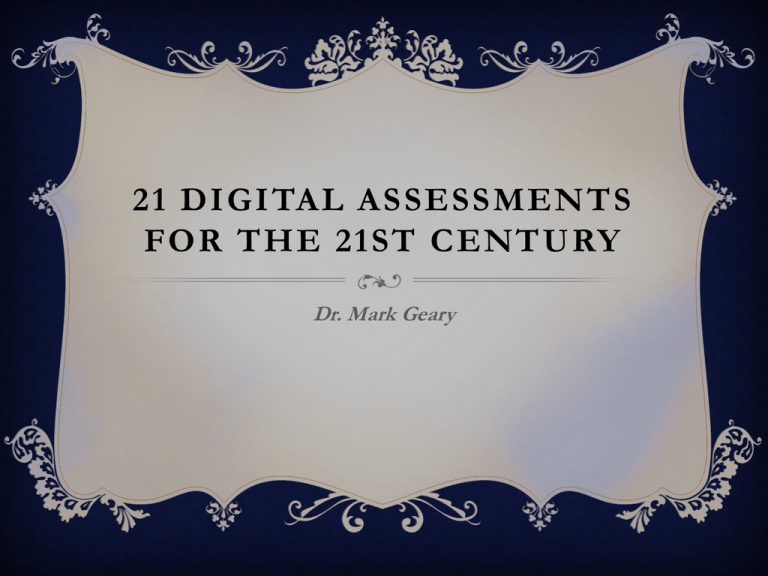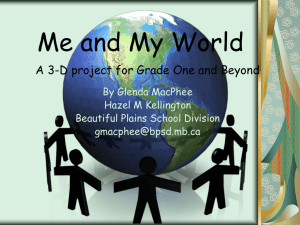21 Digital Assessments for the 21st Century
advertisement

21 DIGITAL ASSESSMENTS FOR THE 21ST CENTURY Dr. Mark Geary 21 ST CENTURY Kids Today? 4 Cs critical thinking and problem solving, communication, collaboration, and creativity and innovation DESCRIPTION So you are doing a blog? Don't pat yourself on the back just yet. This presentation will briefly describe 21 ways you can develop an alternative assessments in any subject area. Help students extend the product of their learning beyond the classroom to a wi der audience, and let parents KNOW you are teaching students 21st centur y skills by giving students 21st century skills artifacts of learning to PROV E their mastery. CHARACTERISTICS 21st Century Assessments will generally have an easily shared digital output. 21st Century Assessments extend the audience for the student’s work or products beyond the classroom. 21st Century Assessments should be respectful of the time demands of teaching, and not require heroic effort to complete or maintain. 21st Century assessments will focus on higher order thinking skills in Bloom’s Taxonomy TOOLS Rubistar.4teachers.org You may not know how to grade what you are doing until after you have done it. On the “first run”, use a very low point value. Then have students evaluate as a class. What makes a project great, or horrible, then work to the center. Schooltube.com for sharing video. Cutepdf printer, for printing pdfs instead of killing trees. CHARACTER ASTROLOGY SIGNS After reading brief descriptions of the astrology or sun signs, figure out which signs you think three of the main characters from your book or scientists or mathematicians were born under. Write an explanation of why you think they fit the sign, drawing on their actions, attitudes, and thoughts from the book. Create a place mark in Google Sky (Google Earth) with an explanation of how that sign describes your person or character. Save as a kml file for sharing. HEROES AND SUPERHEROES Select two or three people your character/Scientist/Mathematician would think of as a hero or superhero. Describe the characteristics of the hero and why those characteristics would be important to your character. Also describe which characteristics your character would most want for himself/herself that the hero or superhero possesses. Create your character at the Marvel Comics SuperHero Gallery. CREATE A CHILDHOOD Using Kidpix, draw a series of slides that show what your character, author, scientist or mathematician as he or she would have been as a child. Save the slides as images, and upload to Voicethread. Or save the slideshow as a .mov file, and upload to schooltube. Write the story of his or her childhood in such a way that shows why he or she is the way he or she is in the novel, or in their biographical information. CRITIQUE FROM THE POINT OF VIEW OF A SPECIFIC ORGANIZATION Select an organization that might have a lot to say about the actions or portrayals of characters in the novel you read, and write a critique of the book from its point of view. For example the Society for the Prevention of Cruelty to Animals might have a lot to say about Lennie’s treatment of animals in Of Mice and Men, The National Association for the Advancement of Colored People on the portrayal of Crooks, and the National Organization of Women on the portrayal of Curley’s wife and the fact that she was never given a name. Use Filamentality to create a webquest with a variety of roles that include that point of view. RADIO EXCHANGE Your character calls into a radio show for advice. Choose which show your character would call in to and then create the conversation he or she would have with the radio advice giver. Post to the audio blog. Or create avatars in VoiceThread to carry on the conversation. MOVIE RECOMMENDATIONS From all the movies you’ve seen in the last couple of years, pick five you would recommend that your character or author or scientist to see. Give a brief summary of each movie and explain why you think the character should see it. Share your recommendation and reasons on IMDB. FAKEBOOK Create a FakeBook page. Select several characters and design a home page for each of them, picking out appropriate backgrounds and pictures and then creating information that would tell a viewer about your character. Also, create links to at least five different sites that you think your character would be interested in. Then write up and post on the page an explanation of how you made the decisions you did and what you believe this tells us about the character. TITLE ACROSTIC Go to Thinkfinity and write the title of the book or key event or element as an acrostic poem. For each letter in the title, construct a sentence that begins with that letter and that tells something significant about the story or event or element. http://www.readwritethink.org/files/resources/interactives/acrostic/ CARTOON SQUARES Create a series of six drawings or squares in Pixton or MakeBeliefscomix that shows a significant event in the novel, or an actual historic or scientific event. Under each picture or cartoon, write a few lines of explanation. If using Make Beliefs Comix, print to pdf to share. WORDLE WORD COLLAGE Write the title of the book in the Wordle text entry three times, to assure it’s prominence. Then look for words, phrases, and sentences that illustrate or tell something about your book, scientific discovery or historical fact. As you look, think in terms of the theme, setting, plot line (if any), as well as characters. Work to get fifty such words, phrases, or sentences so the whole Wordle is well represented. The visual impact of the Wordle should tell a potential reader a lot about the significant ideas. DREAM VACATION Where do you think your character, explorer or scientist would most like to go on a vacation? Pick a spot in Google Maps, describe it, and explain why they would want to go there. Add a placemark and save the map. Download information from the Internet on the place. Then create a photostory or animoto showing a day-by-day itinerary of what the character would do each day. Add descriptions or links to movies in the placemark. If creating a movie, explain why the character or person would like these activities. SCRAP BLOG Think about all the kinds of mementos you would put in a scrap blog if you had one. Then create a scrap blog for your character, scientist, mathematician or explorer, downloading pictures from the Internet or drawing for them in MSPaint or KidPix the mementos he or she would have in a scrap blog. Create and share the poster in Glogster. PHOTOS In Flickr or PhotoBucket, find two or three photos that would have special significance to your character, scientist or explorer. Add the photos to Photostory 3 or iMovie to make a movie about why those pictures would be important to your character. Share your movie in schooltube, and rate each others movies according to a rubric the class agrees on. MUSIC After reading a novel or chapter, figure out how you would divide up the reading into sections. Then select a piece of music from YouTube that you think captures the feel or tone of each section. Download the music using Zamzar.com or AnyVideoConvertor. If possible do voice-overs (Garage Band on the Mac works for this) explaining what is happening in the reading during the piece of music and why you felt this piece of music fit the section of the novel or reading. POETRY Write three poems in response to a story or reading. The poems can be about the characters, where the book took place (setting), or the themes in the book. For younger students struggling to get started, this Shape Poem format may be a good starting point. Thinkfinity can help your students generate many other types of poems as well. Be sure to refine your search using the “Interactives” checkbox. TANGIBLE OR INTANGIBLE GIFTS Select a character, scientist or explorer and figure out what two or three things you believe your character most needs or wants. Draw or download pictures to represent these “gifts” and write to your character an explanation of why you picked these things out for him or her. Share your writing by uploading and sharing your file in acrobat.com. TALK WITH THE AUTHOR Write a letter to the author of the book or chapter explaining to him or her why you think he or she wrote the book and what he or she was trying to show through the book (or chapter). Be sure to explain what you got out of the book. If the author is still alive, send the letter to the author via the publisher of the book or the author’s website. If not, find a blog that discusses the writing, and post your comment there. NOTE: This activity should not be limited to fiction. POINT OF VIEW Have students partner. Write an opinion column like those that appear on the editorial page of the newspaper. Choose a theme or topic from the novel you just read and write the column from the point of view of one of the characters. Your character might write about the importance of education or why we should accept people who are not like us. Post to an appropriate Blog, or create your own just for this topic. Or create a free WIX website with a comments page for sharing. STUDENT WORD TEST STUDENT CREATED WORD TEST Think of fifteen words that are essential to the understanding of the book or chapter. Explain why you picked the words you did and how you would define them in terms of the story or chapter. Share the words in SpellingCity.com, creating definitions when needed. Play a game or puzzle based off of your list. BOOK CHOICES Book choices for character or author. Select a character (or author) and then choose five books for him or her, thinking about what he or she might like and also what you think they need to know more about. Use Amazon.com to select your books. Why did you select the nonfiction books you did? What do you hope your character will like about or get out of the writings? CREATE A BEDROOM What would a teenaged Einstien’s bedroom look like? We learn a lot about people by what they keep in their closets, what they have on their walls, what they select to put in a room. Select a character or author or scientist you know well and create a living room, bedroom, kitchen, or cabin that would mean a lot to the character. Draw it in Google Sketchup or create it in SecondLife, making sure to include an explanation of why you designed the room as you did. ADOBE STORY SCRIPT Student partner to write a movie script using Adobe Story for a favorite scene in a book or chapter just read. At the top of the script, the student can assign real-life TV or movie stars to play each role. The student can also work with classmates to perform the favorite scene. The script can be uploaded into xtranormal, or acted out and uploaded into YouTube or created as a Reader’s Theater script. GOOGLE MAP MAKER Become a Map-Maker. After selecting and reading a book or story or exploration that involves a journey of some sort, students create a detailed map in Google Maps using placemarks. The placemarks can be edited to include descriptions, and even movie links illustrating the significant places (e.g. Taj Mahal) and important geographic locations (India) in the book. The map can be made public and shared. CREDITS Fifty Alternatives to the Book Report by Diana Mitchell English Journal, Jan 98 p 92-95 Challenging, Meaningful, and Even Enjoyable Alternatives to Traditional Book Reports by William P. Bintz, Kent State University, Sara D. Moore, ETA/Cuisenaire, 2010 IRA World Congress THANKS FOR COMING! Questions? Mark.Geary@dsu.edu





